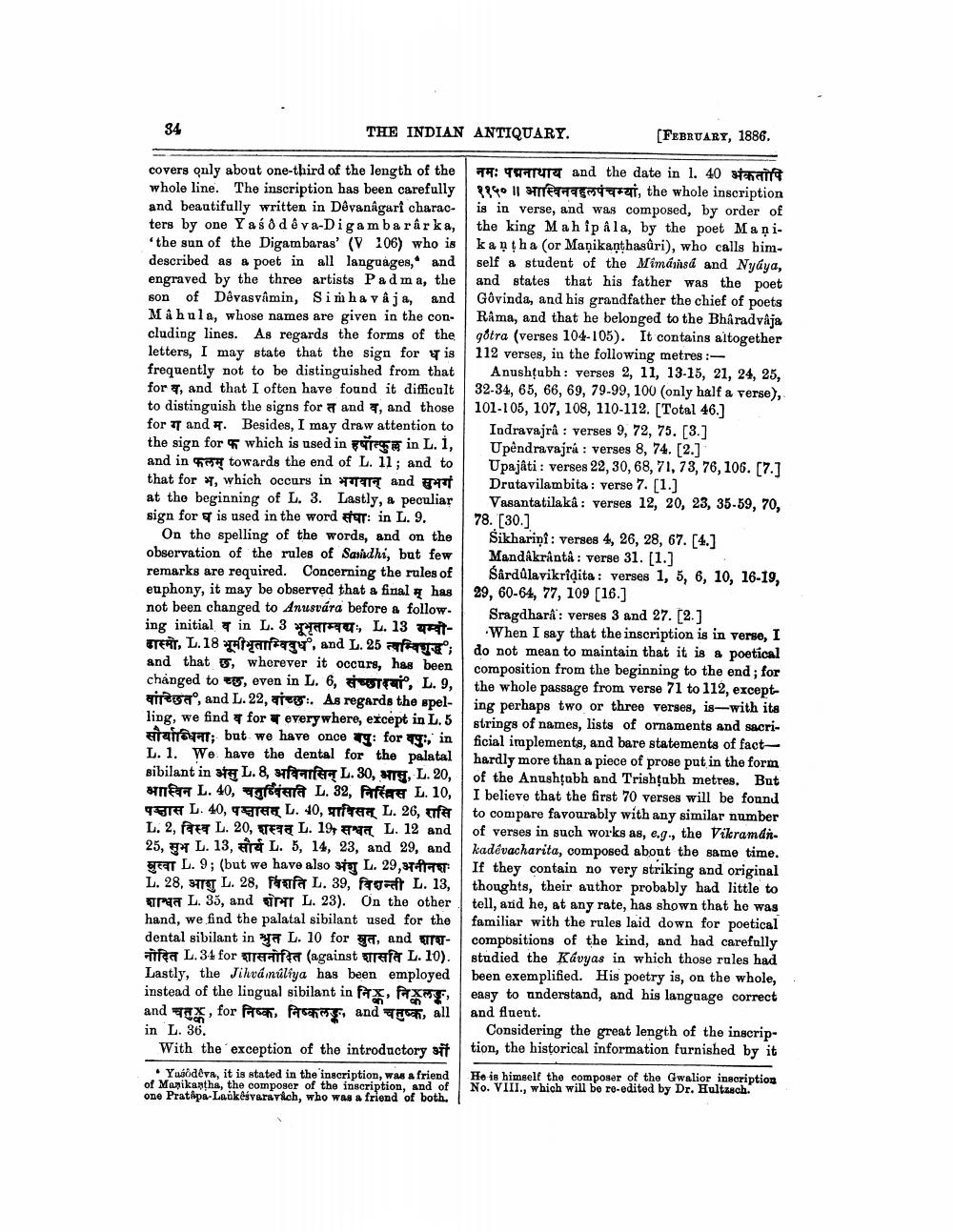________________
34
THE INDIAN ANTIQUARY.
covers only about one-third of the length of the whole line. The inscription has been carefully and beautifully written in Dêvanâgarî characters by one Yasodêva-Digambarârka, 'the sun of the Digambaras' (V 106) who is described as a poet in all languages, and engraved by the three artists Padma, the son of Dêvasvâmin, Simha vâja, and Mahula, whose names are given in the concluding lines. As regards the forms of the letters, I may state that the sign for is frequently not to be distinguished from that for, and that I often have found it difficult to distinguish the signs for a and, and those for and. Besides, I may draw attention to the sign for which is used in ga in L. 1, and in towards the end of L. 11; and to that for भ, which occurs in भगवान् and सुभगं at the beginning of L. 3. Lastly, a peculiar sign for is used in the word : in L. 9.
On the spelling of the words, and on the observation of the rules of Sandhi, but few remarks are required. Concerning the rules of euphony, it may be observed that a final has not been changed to Anusvára before a following initial व in L. 3 भूभृताम्वद्य, L. 13 यम्बीढास्मो, L. 18 भूमीभृताम्विबुध, and L. 25 त्वविशुद्ध and that, wherever it occurs, has been changed to, even in L. 6, Tai, L. 9, area, and L. 22, eg. As regards the spelling, we find for everywhere, except in L. 5 सौर्याब्धिना; but we have once वपुः for वपुः, in L. 1. We have the dental for the palatal sibilant in अंसु L. 8, अविनासिन् L. 30, भालु, L. 20, आस्विन L. 40, चतुब्विंसति L. 32, निस्विस L. 10, पञ्चास L. 40, पञ्चासत् L. 40, प्राविसत् L. 26, रासि L. 2, fra L. 20, L. 19, L. 12 and 25, L. 13, L. 5, 14, 23, and 29, and स्रुत्वा L. 9; (but we have also अंशु L. 29, अनीनशः 1. 28, आशु L. 28, विंशति L. 39, विद्यन्ती L. 13, L. 35, and PT L. 23). On the other hand, we find the palatal sibilant used for the dental sibilant in श्रुत L. 10 for स्रुत, and शाशनोदित L. 34 for शासनोदित (against शासति L. 10). Lastly, the Jilvánuliya has been employed instead of the lingual sibilant in fax, x, and for निष्क, निष्कलङ्क, and चतुष्क, all in L. 36.
3
With the exception of the introductory sff
Yusodeva, it is stated in the inscription, was a friend of Manikantha, the composer of the inscription, and of one Pratapa-Labkéévaravách, who was a friend of both.
[FEBRUARY, 1886.
नमः पद्मनाथाय and the date in 1. 40 अंकतोपि ११५० || आस्विनवहुलपंचम्यां, the whole inscription is in verse, and was composed, by order of the king Mahipala, by the poet Manikantha (or Manikanthasûri), who calls himself a student of the Mimásd and Nyaya, and states that his father was the poet Govinda, and his grandfather the chief of poets Rama, and that he belonged to the Bharadvaja gotra (verses 104-105). It contains altogether 112 verses, in the following metres:
Anushṭubh: verses 2, 11, 13-15, 21, 24, 25, 32-34, 65, 66, 69, 79-99, 100 (only half a verse), 101-105, 107, 108, 110-112. [Total 46.]
Indravajrå: verses 9, 72, 75. [3] Upêndravajrá: verses 8, 74. [2.]
Upajâti: verses 22, 30, 68, 71, 73, 76, 106. [7.] Drutavilambita: verse 7. [1.]
Vasantatilakâ: verses 12, 20, 23, 35-59, 70, 78. [30.]
Sikhariņi: verses 4, 26, 28, 67. [4.] Mandâkrântâ: verse 31. [1.]
Śârdûlavikriḍita: verses 1, 5, 6, 10, 16-19, 29, 60-64, 77, 109 [16.]
Sragdhara: verses 3 and 27. [2.]
When I say that the inscription is in verse, I do not mean to maintain that it is a poetical composition from the beginning to the end; for the whole passage from verse 71 to 112, excepting perhaps two or three verses, is-with its strings of names, lists of ornaments and sacrificial implements, and bare statements of facthardly more than a piece of prose put in the form of the Anushṭubh and Trishṭubh metres. But I believe that the first 70 verses will be found to compare favourably with any similar number of verses in such works as, e.g., the Vikramánkadévacharita, composed about the same time. If they contain no very striking and original thoughts, their author probably had little to tell, and he, at any rate, has shown that he was familiar with the rules laid down for poetical compositions of the kind, and had carefully studied the Kávyas in which those rules had been exemplified. His poetry is, on the whole, easy to understand, and his language correct
and fluent.
Considering the great length of the inscription, the historical information furnished by it
He is himself the composer of the Gwalior inscription No. VIII., which will be re-edited by Dr. Hultzach.




